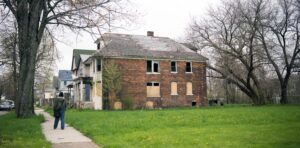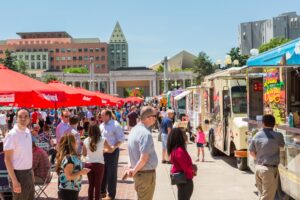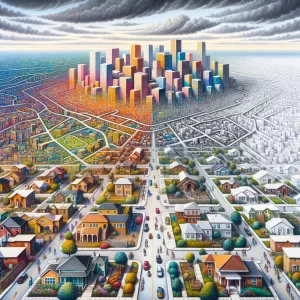White flight, the phenomenon where white residents move from racially mixed urban regions to more homogenous suburban or rural areas, can profoundly affect the social fabric and economic health of communities. Here are 20 indicators that white flight might be occurring in your town, shedding light on underlying societal shifts and challenges.
1. Shift in School Demographics
Local schools may start reflecting a more diverse student body, with a significant decrease in white students as families move to other areas. This demographic shift can impact school funding and resources.
2. Changes in Property Values
Property values in historically stable neighborhoods might begin to decline as homes are listed for sale in large numbers, signaling a potential exodus. This trend can disrupt the local housing market and community stability.
3. Decrease in Local Business Ownership
The disappearance of long-established, white-owned local businesses can indicate community demographic shifts and economic changes. New businesses may cater to a different demographic, altering the local economic landscape.
4. Real Estate Marketing Trends
Real estate advertisements might start targeting buyers in the area, emphasizing the homogeneity of communities further away as a means of pushing specific groups to consider leaving. This marketing shift can essentially encourage relocation based on demographic preferences.
5. Changes in Community Services
A noticeable reduction in the quality or availability of community amenities like parks and libraries might occur, reflecting shifting priorities and resources. This can lead to a decreased quality of life for the remaining residents.
6. Alterations in Public Funding
Public funds might be redirected away from urban areas towards suburban or rural communities, following the movement of wealthier, often white, populations. This shift can exacerbate inequalities between areas.
7. Increase in Rental Properties
An uptick in homes being converted to rentals can suggest that homeowners are moving but retaining properties as investments, anticipating future demographic shifts. This can change the character of neighborhoods from homeowner-dominated to renter-occupied.
8. Shift in Local Political Landscape
The local political scene may start reflecting new priorities and leadership, often in response to changing demographics and concerns. This can lead to policies that further encourage demographic sorting.
9. Decrease in Community Engagement
A decline in active participation in community events and organizations by longstanding white residents can indicate a waning commitment to the area, often preceding relocation. This withdrawal can leave a void in community leadership and cohesion.
10. Changes in Public Perception
The narrative surrounding a town might shift, focusing more on negative aspects like crime or educational challenges, which can be coded language hinting at racial demographic changes. This altered perception can stigmatize areas and accelerate white flight.
11. Decline in Neighborhood Associations
Neighborhood associations may become less active or dissolve entirely as longstanding residents move away, reducing community oversight and involvement in local issues. This can lead to a decline in neighborhood upkeep and a sense of community.
12. Increase in Vacant Properties
An uptick in vacant homes and commercial properties can be a telltale sign of a community in transition, often preceding a demographic shift. Vacancies can attract vandalism and contribute to a sense of neglect.
13. Shift in Religious Institutions
Local churches and religious institutions that once served as community anchors may experience declining attendance or close altogether as their congregations relocate. New congregations may form, reflecting the changing demographics.
14. Changes in Public Transportation Usage
Public transportation routes and usage patterns may change, with services being rerouted or reduced in areas experiencing white flight. This can impact accessibility and connectivity for remaining residents.
15. Evolution of Cultural Festivals
Cultural festivals and events that have long been traditions in the community might be discontinued or evolve to cater to a new demographic makeup. This shift reflects changing cultural and social dynamics.
16. Transformation of Retail Landscapes
The retail landscape may begin to transform, with longstanding shops closing and new stores opening to cater to different cultural tastes and economic levels. This can alter the character and vibrancy of commercial districts.
17. Changes in Healthcare Facilities
Local healthcare facilities, including clinics and hospitals, might adjust services or relocate in response to changing community needs and demographics. Access to healthcare can become a concern for the remaining populations.
18. Adjustment in Law Enforcement Practices
Law enforcement practices and community policing strategies may shift, reflecting new community dynamics and possibly leading to tensions. These changes can influence residents’ sense of safety and community trust.
19. Fluctuation in Local Media Coverage
Local media coverage may shift focus, highlighting issues and stories that resonate more with suburban or rural communities rather than urban concerns. This can affect public perception and community engagement.
20. Alteration in Historic Preservation Efforts
Efforts to preserve local history and landmarks might wane as the community’s demographic makeup changes, leading to the potential loss of cultural heritage. This can affect community identity and tourism.
Why Recognizing Signs of White Flight Is Critical
Understanding these indicators is crucial for addressing the root causes of white flight and fostering inclusive, resilient communities. By recognizing these signs, local leaders and residents can work together to create strategies that promote diversity, equity, and economic stability.
Catherine is a tech-savvy writer who has focused on the personal finance space for more than eight years. She has a Bachelor’s in Information Technology and enjoys showcasing how tech can simplify everyday personal finance tasks like budgeting, spending tracking, and planning for the future. Additionally, she’s explored the ins and outs of the world of side hustles and loves to share what she’s learned along the way. When she’s not working, you can find her relaxing at home in the Pacific Northwest with her two cats or enjoying a cup of coffee at her neighborhood cafe.













































